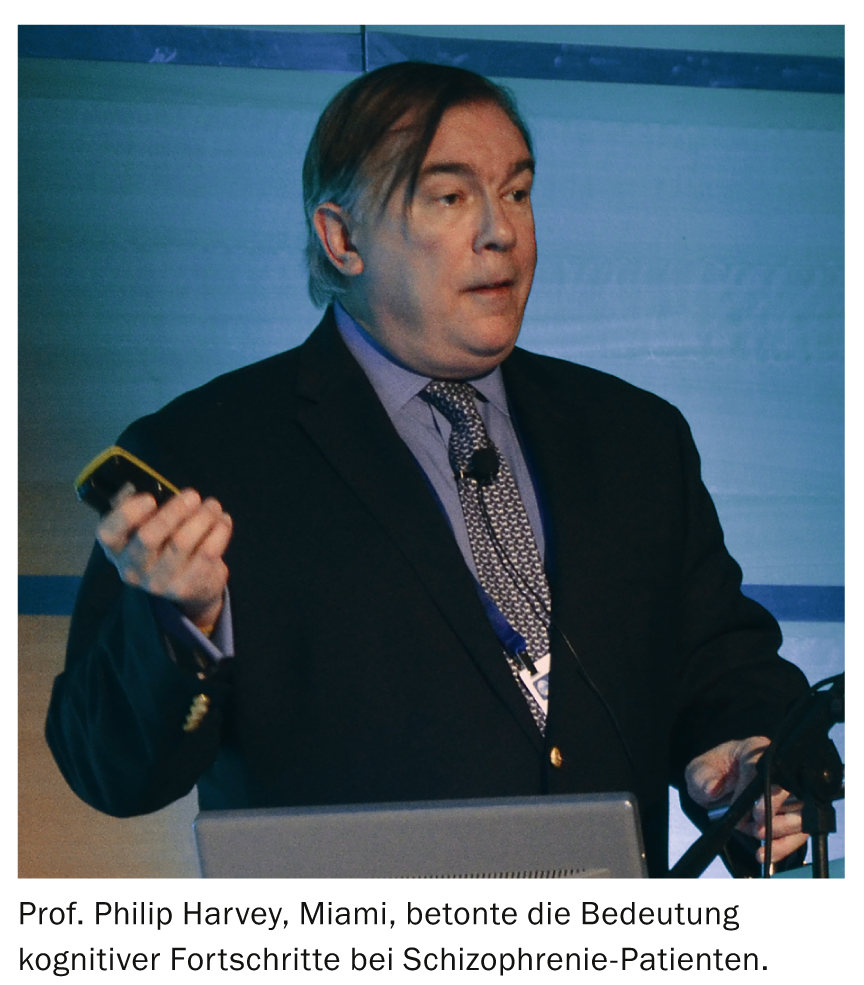Experts discussed new research results and findings on biomarkers, neuroimaging, and cognitive impairment in schizophrenia at the EPA Congress in Munich. The focus was on the question of new therapeutic strategies: what role do dosage, placebo control and mediatizing factors play in the interpretation of different outcomes? How do atypical antipsychotics compare?
(ag) According to Prof. Peter Falkai, MD, Munich, Germany, the identification of individuals at high risk for the onset of psychosis has previously relied on prodromal symptomatology. A few years ago, however, it was shown that machine learning algorithms can be used to perform diagnostic classification of neuropsychiatric patient populations, based on MRI data. For example, in 2009 [1] it was investigated to what extent such a multivariate neuroanatomical pattern classification facilitates the identification of different so-called “at-risk mental states” (ARMS, i.e. risk populations for psychosis/schizophrenia). Furthermore, the question was whether this would make it possible to predict the individual disease transition. Twenty individuals in early ARMS, 25 in late ARMS, and 25 matched healthy control participants were classified for patterns based on their structural MRI data. Predictive value should be evident after four years of clinical follow-up based on transitions to psychosis that have occurred. The authors conclude that the various ARMS and their clinical outcomes can be reliably identified using individual pattern recording, based on neuroanatomical abnormalities throughout the brain. Thus, the patterns could serve as valuable biomarkers for disease detection in the prodromal psychosis phase.
So-called genome-wide association studies have identified the rs1344706 genotype as a common risk variant for schizophrenia and bipolar disorder. However, a recent study [2] showed that the results of such studies cannot be fully replicated and further independent confirmatory studies are urgently needed in this regard.
Biomarkers only in dementias
“Although the introduction of biomarkers in medicine has made great progress in recent years, in the field of mental disorders biomarkers have so far only been introduced for dementias. Development in psychoses is still in its infancy. However, it is likely that imaging and genetic markers will be useful in the future to predict progression from prodrome to full-blown clinical picture and to identify subgroups where causal therapies can then be found,” says Prof. Falkai.
Update on treatment options
What can be said about cognitive functionality in schizophrenia? Prof. Philip Harvey, Miami, asked himself this question: “On the one hand, cognitive impairment is ubiquitous, profound and limiting. For another, it occurs early and persists for a long time. It thus not only limits professional success and has an impact on private life circumstances, but above all leads to loneliness and isolation. So how can functionality be improved?”

Lurasidone is a new atypical antipsychotic that is active at several potentially important receptive sites. Moreover, it is associated with minimal, clinically irrelevant weight gain [3,4]. Its efficacy in schizophrenia is primarily attributed to a combination of antagonism at central dopamine type 2 (D2) and serotonin type 2 (5HT2A) receptors. In vitro studies investigated the receptor binding profile and demonstrated that the drug has high antagonistic affinity to dopamine D2 receptors, 5-HT2A, 5-HT7, and partial affinity to serotonin 5-HT1A receptors. In contrast, the affinity for histamine H1 and muscarinic (M1) receptors is negligibly weak [5].
Improve cognitive deficits
“In our 2011 study [6], we found a trend toward significantly greater improvement (p=0.058) on the interview-based SCoRS scale under lurasidone (compared to baseline) when comparing ziprasidone to lurasidone. Thus, such cognitive measures may be sensitive to change after only three weeks of treatment in patients with schizophrenia. Recently, moreover, we compared the agent with quetiapine XR in a study [7]. A six-week, placebo-controlled, acute treatment phase and a six-month, double-blind, prolonged treatment phase were studied for improvements in cognitive performance and functional capacity (CogState, UPSA-B measure),” Prof. Harvey explained. In the evaluable subsample (n=267), lurasidone at the 160 mg dose (but not the 80 mg dose) significantly outperformed both placebo and quetiapine XR in cognitive outcome at six weeks. UPSA-B scores were superior to placebo for all therapies.
In the extension, analysis of the sample that could be fully evaluated this time showed significantly better cognitive performance for lurasidone at all doses compared with quetiapine XR at both three and six months. “The results are encouraging, but of course they need to be replicated. A mediating factor within all treatment groups could also be disease awareness, which may have a global impact on performance,” said Prof. Harvey.
Lack of insight decisive
The so-called insight concept describes the lack of awareness of deficits, consequences and treatment needs of a disease, in this case schizophrenia. Patients often lack such insight into their condition and associated symptoms, which may be associated with deficits in self-assessment of cognitive and functional capabilities and quality-of-life outcomes. A study by Prof. Harvey [8], also presented at the EPA Congress, examined the extent to which therapy-associated improvement in disease awareness had an impact on changes in cognitive and functional outcomes. Compared with placebo, insight scores (PANSS G12) improved significantly with both quetiapine XR and lurasidone at six weeks. In contrast, at week 32, levels in the lurasidone group were significantly higher than those in the quetiapine XR group. Improved insight at week 6 was a significant mediator of the effect of lurasidone 160 mg (vs. placebo) on the “neurocognitive composite score,” total UPSA-B score, and the so-called “quality of well-being” (QWB) scale. At weeks 19 and 32, improved insight was significantly associated with increases in UPSA-B and QWB scores. Thus, improved disease awareness exerted a statistically significant influence on cognition and functional outcomes.
Daytime sleepiness is also discussed as a possible mediator of functional capacity with quetiapine XR. In studies, it was associated with deterioration in this area [9].
Placebo control necessary for interpretation
“Cognitive changes that occur with pharmacological interventions have critical functional relevance, even in the short term. Lurasidone is the first antipsychotic agent to show a change in cognition and functional capacity and a broad range of cognitive improvement in a placebo-controlled trial. The placebo control is crucial for the interpretation of the results. The differences in side effects may account in part for the differences between quetiapine XR and lurasidone 160 mg/tgl. be responsible,” concluded Prof. Harvey.
Source: “Advancing Schizophrenia: From Markers to Management,” Satellite Symposium at the 22nd European Congress of Psychiatry, March 1-4, 2014, Munich, Germany.
Literature:
- Koutsouleris N, et al: Use of neuroanatomical pattern classification to identify subjects in at-risk mental states of psychosis and predict disease transition. Arch Gen Psychiatry 2009 Jul; 66(7): 700-712. doi: 10.1001/archgenpsychiatry.2009.62.
- Paulus FM, et al: Partial support for ZNF804A genotype-dependent alterations in prefrontal connectivity. Hum Brain Mapp 2013 Feb; 34(2): 304-313. doi: 10.1002/hbm.21434. epub 2011 Oct 31.
- Loebel A, et al: Effectiveness of lurasidone vs. quetiapine XR for relapse prevention in schizophrenia: a 12-month, double-blind, noninferiority study. Schizophr Res 2013 Jun; 147(1): 95-102. doi: 10.1016/j.schres.2013.03.013. epub 2013 Apr 11.
- Citrome L, et al: Long-term safety and tolerability of lurasidone in schizophrenia: a 12-month, double-blind, active-controlled study. Int Clin Psychopharmacol 2012 May; 27(3): 165-176. doi: 10.1097/YIC.0b013e32835281ef.
- Ishibashi T, et al: Pharmacological profile of lurasidone, a novel antipsychotic agent with potent 5-hydroxytryptamine 7 (5-HT7) and 5-HT1A receptor activity. J Pharmacol Exp Ther 2010 Jul; 334(1): 171-181. doi: 10.1124/jpet.110.167346. epub 2010 Apr 19.
- Harvey PD, et al: Performance and interview-based assessments of cognitive change in a randomized, double-blind comparison of lurasidone vs. ziprasidone. Schizophr Res 2011 Apr; 127(1-3): 188-194. doi: 10.1016/j.schres.2011.01.004. Epub 2011 Jan 31.
- Harvey PD, et al: Effect of lurasidone on neurocognitive performance in patients with schizophrenia: a short-term placebo- and active-controlled study followed by a 6-month double-blind extension. Eur Neuropsychopharmacol 2013 Nov; 23(11): 1373-1382. doi: 10.1016/j.euroneuro.2013.08.003. epub 2013 Aug 27.
- Harvey P, et al: Impact of improved insight in schizophrenia: a double-blind lurasidone and quetiapine xr study. European Psychiatry 2014; Article: EPA-0321.
- Loebel AD, et al: Daytime sleepiness associated with lurasidone and quetiapine XR: results from a randomized double-blind, placebo-controlled trial in patients with schizophrenia. CNS Spectr 2014 Apr; 19(2): 197-205. doi: 10.1017/S1092852913000904. Epub 2013 Dec 13.
InFo NEUROLOGY & PSYCHIATRY 2014; 12(3): 36-38.











